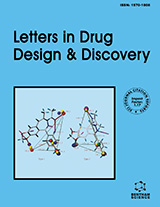Abstract
Estrogen receptors exist as two subtypes ERα and ERβ, which are characterized by various distributions in human tissues and diverse transcription regulation. Ligands capable of selective ERβ activation show positive effects in treatment of such diseases as certain cancers, endometriosis, inflammatory diseases, and assist in maintaining cardiovascular and nervous system health. Thus far, there are no pharmaceutical drugs available acting on this target. In order to provide new treatment for such diseases, a new generation of selective estrogen receptor modulators is required. This remains an unsolved task due to several difficulties. It is known that minor modifications of ER agonists can influence the selectivity of their binding. The majority of designed ligands acting on ER possess chiral centers thus exist as stereoisomers. Unfortunately, not every spatial isomer is individually considered in experimental research. The molecular docking was applied to investigate the structural basis of diverse selectivity and binding affinity of selected estrogen receptor β agonists. Docking simulations revealed that terminal aromatic rings positioned in the A- and D-ring regions are a factor that determines binding affinity of ERβ agonists. This positioning can be ascribed to the presence of two terminal hydroxyl groups, a rigid linker, and the introduction of aliphatic substituents. The side substituents of underlined molecular scaffold should adopt inside characterized cavities I and II in order to provide selectivity. The bulkiness, attachment to linker and stereochemistry of the substituents affect ERβ selectivity. These molecular features should be considered during search and design of new improved ERβ agonists.
Keywords: Estrogen receptor beta, selective agonists, structure based drug design, pharmacophore model, docking, molecular recognition.
Current Computer-Aided Drug Design
Title:Molecular Docking Reveals Binding Features of Estrogen Receptor Beta Selective Ligands
Volume: 11 Issue: 2
Author(s): Pawel Ksiazek and Krzysztof Bryl
Affiliation:
Keywords: Estrogen receptor beta, selective agonists, structure based drug design, pharmacophore model, docking, molecular recognition.
Abstract: Estrogen receptors exist as two subtypes ERα and ERβ, which are characterized by various distributions in human tissues and diverse transcription regulation. Ligands capable of selective ERβ activation show positive effects in treatment of such diseases as certain cancers, endometriosis, inflammatory diseases, and assist in maintaining cardiovascular and nervous system health. Thus far, there are no pharmaceutical drugs available acting on this target. In order to provide new treatment for such diseases, a new generation of selective estrogen receptor modulators is required. This remains an unsolved task due to several difficulties. It is known that minor modifications of ER agonists can influence the selectivity of their binding. The majority of designed ligands acting on ER possess chiral centers thus exist as stereoisomers. Unfortunately, not every spatial isomer is individually considered in experimental research. The molecular docking was applied to investigate the structural basis of diverse selectivity and binding affinity of selected estrogen receptor β agonists. Docking simulations revealed that terminal aromatic rings positioned in the A- and D-ring regions are a factor that determines binding affinity of ERβ agonists. This positioning can be ascribed to the presence of two terminal hydroxyl groups, a rigid linker, and the introduction of aliphatic substituents. The side substituents of underlined molecular scaffold should adopt inside characterized cavities I and II in order to provide selectivity. The bulkiness, attachment to linker and stereochemistry of the substituents affect ERβ selectivity. These molecular features should be considered during search and design of new improved ERβ agonists.
Export Options
About this article
Cite this article as:
Ksiazek Pawel and Bryl Krzysztof, Molecular Docking Reveals Binding Features of Estrogen Receptor Beta Selective Ligands, Current Computer-Aided Drug Design 2015; 11 (2) . https://dx.doi.org/10.2174/1573409911666150722121814
| DOI https://dx.doi.org/10.2174/1573409911666150722121814 |
Print ISSN 1573-4099 |
| Publisher Name Bentham Science Publisher |
Online ISSN 1875-6697 |
 46
46
- Author Guidelines
- Bentham Author Support Services (BASS)
- Graphical Abstracts
- Fabricating and Stating False Information
- Research Misconduct
- Post Publication Discussions and Corrections
- Publishing Ethics and Rectitude
- Increase Visibility of Your Article
- Archiving Policies
- Peer Review Workflow
- Order Your Article Before Print
- Promote Your Article
- Manuscript Transfer Facility
- Editorial Policies
- Allegations from Whistleblowers


























